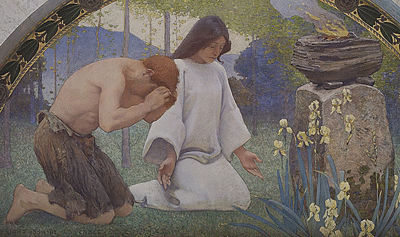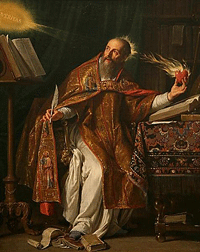 Faith & Worship
Faith & Worship
If we go back to the very early Christians, living in the Middle East in the 1st and 2nd Centuries AD we find them spread thinly around the Roman world and beyond. They lived quietly in a pagan society, meeting in homes and informal gatherings. But they lived different lives to their pagan neighbours, living by simple creeds or confessions of faith.
At this time the Word of God passed from congregation to congregation by word of mouth rather than through Scripture. Until 382AD there was no authorised and complete Old and New Testament, just the Jewish Septuagint, and within those pages they looked for prophesies relating to the Messiah. The oral tradition handed down from generation to another was highly regarded, with Papias of Hierapolis, writing in c130 advising Christians to give greater prominence to the oral rather than the written word.
However, when the written text became more readily available, Christians had a real advantage over the pagans who relied on oral myths.
Gradually the fledgling church organised itself, settling arguements over doctrine and creating a leadership which linked its origins directly to the Apostles, with the Bishop as God's representative on earth.
The early church was located mainly in towns, rather than country areas. In AD251 there were 154 ministers in Rome caring for 1500 widows and poor people, and of 80 bshops in North Africa only 4 were in rural areas. They were predominently from the working classes and attractive to women. This would have been due to the respect that was shown to women in a male-dominated society.
Christians placed great importance on chastity and the virtues of sexual abstinence and virginity, which placed them poles apart from the hedonistic lives of their pagain neighbours. The Christians concept of Koinonia or loving fellowship, with its emphasis on care and concern for everyone, including widows and the poor was attractive to outsiders.
In the early centuries of the church it did suffer both internally (with doctrinal arguements) and externally with oppression and outright opposition from the Roman auhorities. This began as early as AD64 when Christians got the blame for the terrible fire that swept through Rome (others blamed Nero!) and this carried on for the next couple of centuries or so. On the 23rd February 303 the emperor Diocletan issued decrees ordering the destruction of churches, the banning of services, burning of scriptures and a loss of privileges for Christians. He went further and ordered Christians to offer pagan sacrifices, as well as imprisoning clergy.
Christians who refused to bow to this pressure either died or went underground.
Persecution ended around AD311 when Constantine began his rule, attributing a military victory to the intervention of the God of the Christians.
From now onward (at least for a while) Christianity was not only tolerated, it was the religion of the state.
There were a few hiccups in the triumph of Christianity over Paganism within the Roman Empire post Constantine, but from the late 4th century the highest authority in the empire would be Christian, supported by the long arm of the sword!
Paganism did of course survive, as a philosophical movement, but gradually the pagan festivals and celebrations were Christrianized. Christmas, as a celebration of Christ's birth was first mentioned in a calendar of AD336 and embraced the pagan festival of Natalis Solis Invicti - with echoes of the Roman Saturnalia. Similarly, the celebration of the ANglo-Saxon goddess Eostre was transformed into the Christian Easter.
This Christianization of the Pagan celebrations might also explain why Christianity was so successful in its missionary goals - to a fairly simple population the edges were becoming blurred. As a result the church grew and prospered. Many new churches were built in the 4th and 5th centuries, becoming centres of Christian community - holy places within which the development of liturgy, ceremony and vestments took place.
At this time we begin to see growth in the veneration of saints and angels, and the importance of the tombs of martyrs. Saints were prayed to as they were believed to intercede with God on behalf of humans. Healings and exorcisms took place at shrines. It is said that 73 people were healed when the the presumed body of the first martyr, St Stephen was discovered in North Africa in AD415.
Remains of saints were divided up between churches so that all could benefit, and soon all churches wanted their own saintly relic. Canon Law in the Catholic church still prohibits a church from being consecrated unless it has a saint's relics installed within the walls. There were voices of criticism against this practice, but they were in a minority.
The cult of relics reinforced Christian views of the afterlife, but a fine line was drawn in that these relics could be venerated but not worshipped.
 While
all this was going on, bishops and clergy were deep in discussion and
arguement over the finer detail of church doctrine, particularly when
it came to what the church believed about the nature of Christ. Many alternative
explanations, Arianism in particular challenged the perceived opinion
over Christ's equality with God. A general council at Constantinople in
AD381 rejected Arianism. A Spanish heretic, Prescillian, bishop of Avila
was put to death for his views.
While
all this was going on, bishops and clergy were deep in discussion and
arguement over the finer detail of church doctrine, particularly when
it came to what the church believed about the nature of Christ. Many alternative
explanations, Arianism in particular challenged the perceived opinion
over Christ's equality with God. A general council at Constantinople in
AD381 rejected Arianism. A Spanish heretic, Prescillian, bishop of Avila
was put to death for his views.
Another general council at Chalcedon is October AD451 sought to confirm belief in he nature of Jesus as one person with two natures (human and divine)
At this time we see the emergence of three famous characters of the early church, At Ambrose, St Jerome and St Augustine who championed orthodoxy in their teaching. Augustine in particular was very influential, and his teaching was to reach outward and beyond to the time of the great protestant reformers of Luther and Calvin.
Next Page....... Monasticism, the journey to Ireland and beyond
See also The 'Confessio' of St Patrick
References
Green, Vivian: A New History of Christianity, Sutton Publishing Ltd
Various Wikipedia articles (OK, I admit I'm not a proper historian!)

©John Birch · Prayers written by the author may be copied freely for worship. If reproduced elsewhere please acknowledge author/website
Privacy Policy · Links · Author · Donate